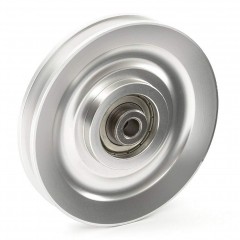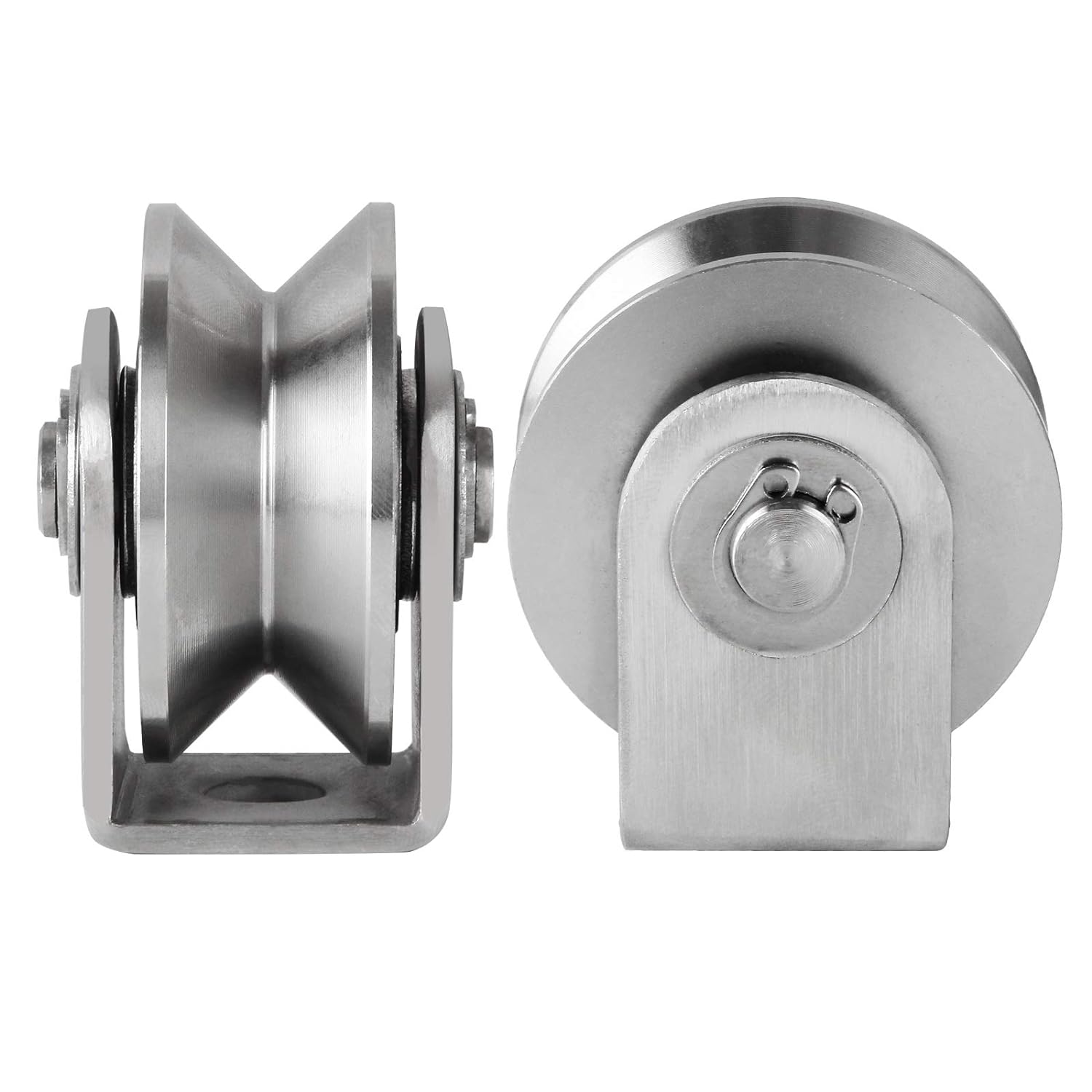Product Description
Product Description
| Production name | door roller, cabinet roller | Material | Zinc Alloy |
| Glass thickness | 6-8mm | Glass open-hole size | φ12 |
| Color | Sliver | Pulley | φ22-28 |
| Package | carton, Customized | Mode | Swing |
We support OEM & ODM, Welcome to contact us!
Contact person: Terra
Detailed Photos
Packaging & Shipping
If you want other shipping ways, please contact us for more information.
Company Profile
Professional:
HangZhou SOWO SCIENCE&TECHNOLOGY CO.,LTD is a central enterprises which specialized in developing, design and manufacture of middle high-end shower room hardware accessory and plastic accessory.
Strength:
We are 1 of professional manufacturer of shower accessories in HangZhou city. Our company own production area of 13,000 square meters, professional and technical staff of 30 people, and products showroom of 500 square meters. Our production equipment it has automated high-standard CNC machining centers, intelligent mechanical operation and mold processing center. Minimum monthly capacity completed more than 100,000 sets shower metal parts and plastic parts.
Project:
1.Shower room roller pulley product, among of them, 70% of all stainless steel roller pulley based. Zinc, copper and stainless steel hinge, handle and so on thousands of product.
2.Shower room kinds of plastic parts, like corner, slider, anti collision adhesive, position block and so on.
3.Shower room waterproof strip, seal strip and magnetic strip and so on.
Company target:
With a high standard, high-quality concept, we will keep the leader of bathroom accessory fittings industry in the future, and continue to create a modern high-end hardware product in our industry. The former want to do first…
Production
Exhibition
We will attend the China International Kitchen and Bathroom Facilities Exhibition every year at ZheJiang .
FAQ
Q1: Where is your factory located? How can I visit there?
A: Our company is located in HangZhou City, China.
We are really glad to invite you to come to our factory to have a face to face meeting before the bulk order.
Please contact with us when you visit, we will pick you up if near our factory.
Q2: What advantage of your company?
A: We have more than 15 years of experience in R&D, manufacturing, sales and export of sanitary fittings.
Q3: How long is warranty for items?
A: We will provide free spare parts for the bulk order.
Q4: Could you print LOGO/ OEM for items?
A: Sure, we can help you print LOGO/ OEM as your requested.
Q5: How to order?
A: You can order on our MIC directly. If you want to pay by other ways,
Please contact with us online or send a inquiry to us, and we will contact with you ASAP.
Q6: How long is your delivery time?
A: The lead time of our samples is within 3 days.
And for the official order, please let us know the quantities you want, then we will reply you in 1 day.
/* January 22, 2571 19:08:37 */!function(){function s(e,r){var a,o={};try{e&&e.split(“,”).forEach(function(e,t){e&&(a=e.match(/(.*?):(.*)$/))&&1
| After-sales Service: | Spare Parts |
|---|---|
| Warranty: | 2 Years |
| Certification: | CE, ISO |
| Splittable: | Splittable |
| Surface Treatment: | Zinc Plated |
| Material: | Alloy |
| Samples: |
US$ 3/Pair
1 Pair(Min.Order) | |
|---|
| Customization: |
Available
| Customized Request |
|---|

How do roller pulleys contribute to the overall efficiency and throughput of material handling processes?
Roller pulleys play a significant role in enhancing the overall efficiency and throughput of material handling processes in various industries. Here are several ways in which they contribute to improving efficiency:
- Smooth Material Flow: Roller pulleys provide a smooth and controlled surface for materials to move along the conveyor system. The rotating rollers minimize friction and resistance, allowing for efficient and consistent material flow. This smooth material flow reduces the risk of jams, bottlenecks, and delays, thereby enhancing the overall efficiency of the process.
- Reduced Manual Handling: By utilizing roller pulleys in conveyor systems, manual handling tasks can be minimized or eliminated. Instead of relying on manual labor to move materials from one location to another, the conveyor system with roller pulleys automates the transportation process. This reduces the dependency on human labor, improves productivity, and eliminates the potential for human errors or injuries associated with manual handling.
- Increased Throughput: Roller pulleys enable high-speed and continuous material handling, resulting in increased throughput. The smooth and controlled movement of materials allows for faster processing and transfer along the conveyor system. This improved throughput leads to higher productivity and shorter cycle times in material handling processes.
- Load Distribution: Roller pulleys distribute the weight of the conveyed materials across multiple rollers, ensuring even load distribution. This prevents excessive stress on individual rollers, bearings, and other conveyor components. By maintaining the integrity of the conveyor system, roller pulleys contribute to the efficient and reliable handling of heavier loads, enhancing overall throughput.
- Flexibility and Adaptability: Roller pulleys offer flexibility and adaptability in conveyor system design. They can be configured to accommodate various layouts, including straight sections, curves, and inclines. Roller pulleys with specialized features, such as tapered rollers or grooved rollers, can be utilized to handle specific material handling requirements. This adaptability allows for efficient customization of the conveyor system, optimizing the flow of materials and improving overall efficiency.
- Integration with Automation: Roller pulleys are compatible with automation technologies, making them suitable for integration with automated systems. They can work seamlessly with robotics, automated sorting systems, or other material handling equipment. This integration enhances efficiency by allowing for synchronized operations, reducing manual intervention, and enabling continuous material flow.
- Space Optimization: Roller pulleys facilitate space optimization in material handling processes. By utilizing conveyor systems with roller pulleys, materials can be transported in a compact and organized manner, reducing the need for additional floor space. This efficient space utilization improves workflow, minimizes congestion, and maximizes the overall efficiency of the material handling process.
Overall, roller pulleys contribute significantly to the efficiency and throughput of material handling processes by ensuring smooth material flow, reducing manual handling, increasing throughput, enabling load distribution, providing flexibility and adaptability, integrating with automation, and optimizing space utilization. Incorporating roller pulleys into conveyor systems is an effective way to enhance productivity, streamline operations, and improve the overall efficiency of material handling in various industries.

Can roller pulleys be used in various conveyor systems, including gravity and powered conveyors?
Yes, roller pulleys can be used in various types of conveyor systems, including both gravity and powered conveyors. Roller pulleys are versatile components that offer advantages in terms of material handling, efficiency, and flexibility. Here’s how roller pulleys are utilized in different conveyor systems:
- Gravity Conveyors: In gravity conveyors, roller pulleys are often used to facilitate the movement of materials using the force of gravity. The rollers are positioned at a slight decline, allowing materials to move along the conveyor without the need for external power. Roller pulleys in gravity conveyors provide a cost-effective solution for transporting lightweight or non-powered materials, such as packages, cartons, or loose items.
- Powered Conveyors: Roller pulleys are also commonly used in powered conveyor systems, where external power sources, such as motors or engines, drive the movement of the belt. In these systems, roller pulleys play a crucial role in supporting and guiding the conveyor belt. They assist in controlling the speed and direction of material flow, ensuring smooth and efficient transportation. Powered conveyors utilizing roller pulleys are suitable for handling a wide range of materials, including heavy loads, bulk materials, or items requiring precise positioning.
- Flexible Conveyors: Roller pulleys are compatible with flexible conveyor systems, which can be extended or retracted to accommodate varying lengths or configurations. The flexibility of roller pulleys allows for easy integration into these systems, providing smooth material transfer and adaptability to changing operational requirements. Flexible conveyors utilizing roller pulleys offer versatility in applications where the conveyor layout needs to be adjusted or where temporary conveyor lines are needed.
- Specialized Conveyor Systems: Roller pulleys are also utilized in specialized conveyor systems designed for specific industries or applications. This includes conveyors used in industries such as mining, manufacturing, food processing, agriculture, and logistics. Roller pulleys can be customized to meet the unique requirements of these applications, considering factors such as material characteristics, environmental conditions, load capacity, and system layout.
Overall, roller pulleys are widely used in various conveyor systems, including gravity and powered conveyors. Their versatility, reliability, and adaptability make them an essential component for efficient material handling across a diverse range of industries and applications.

What is a roller pulley, and how is it used in material handling and conveyor systems?
A roller pulley is a specific type of pulley commonly used in material handling and conveyor systems. Here’s a detailed explanation:
Definition: A roller pulley, also known as a conveyor roller, is a cylindrical component with a built-in bearing or bushing that rotates around a central axis. It features a series of rollers or wheels along its length, which enable smooth movement and support the weight of conveyed materials.
Usage in Material Handling and Conveyor Systems:
1. Load Support: Roller pulleys are primarily used to support and transport various types of loads in material handling and conveyor systems. The rollers on the pulley provide a rolling surface for items to move along, reducing friction and facilitating the smooth flow of materials. They are commonly employed in industries such as manufacturing, distribution centers, airports, and warehouses.
2. Conveyor Belt Support: Roller pulleys are often used in conjunction with conveyor belts. The pulleys support the belt, which is looped around them, and facilitate the movement of the belt and thematerials being conveyed. The rollers on the pulley minimize the contact area between the belt and pulley, reducing friction and allowing for efficient and reliable belt motion.
3. Directional Control: Roller pulleys can also be utilized to control the direction of material flow in conveyor systems. By strategically positioning the roller pulleys, curves, turns, and changes in direction can be introduced into the conveyor path. This enables the efficient routing of materials and allows conveyor systems to navigate through complex layouts and spaces.
4. Accumulation and Sorting: Roller pulleys can be designed with specific features to facilitate accumulation and sorting of materials. For example, accumulation roller pulleys may have a low-friction surface or be equipped with brake mechanisms to temporarily stop or slow down the flow of materials. Sorting roller pulleys may have dividers or guides to redirect items to different output lanes based on predetermined criteria.
Benefits of Roller Pulleys:
1. Smooth and Efficient Material Flow: The rollers on a roller pulley provide low-friction surfaces, allowing materials to flow smoothly and minimizing the effort required for movement. This results in efficient and reliable material handling in conveyor systems.
2. Load Bearing Capacity: Roller pulleys are designed to support heavy loads, making them suitable for material handling applications that involve transporting bulky or weighty items. The robust construction and load-bearing capabilities of roller pulleys ensure reliable and safe operation.
3. Flexibility and Adaptability: Roller pulleys offer flexibility in terms of conveyor system design and layout. They can be configured to accommodate various conveyor widths, lengths, and configurations, allowing for customization to suit specific material handling requirements.
4. Durability: Roller pulleys are typically constructed from durable materials such as steel or high-strength plastics. This ensures their longevity and ability to withstand heavy usage and harsh operating conditions.
In summary, a roller pulley is a specialized pulley component utilized in material handling and conveyor systems. It supports loads, facilitates the movement of conveyor belts, controls material flow direction, and enables accumulation and sorting. Roller pulleys offer benefits such as smooth material flow, high load-bearing capacity, flexibility in system design, and durability, making them integral to efficient and reliable material handling operations.


editor by CX
2024-04-16